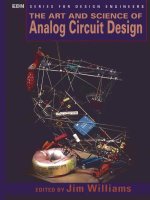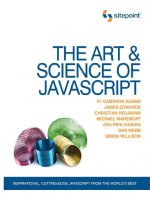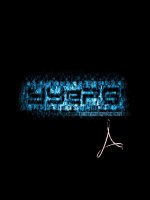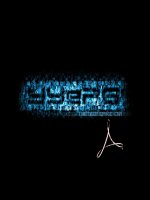williams, j. (1998). the art and science of analog circuit design
Bạn đang xem bản rút gọn của tài liệu. Xem và tải ngay bản đầy đủ của tài liệu tại đây (25.97 MB, 415 trang )
The
Art
and
Science
of
Analog
Circuit Design
The
EDN
Series
for
Design
Engineers
J.
Williams
J.
Lenk
V.
Lakshminarayanan
J.
Lenk
M.
Brown
B.
Travis
and I.
Hickman
J.
Dostal
T.
Williams
R.
Marston
N. Dye and H.
Granberg
Gates
Energy Products
T.
Williams
J.
Williams
R.
Pease
I.
Hickman
R.
Marston
R.
Marston
I.
Sinclair
The
Art and
Science
of
Analog Circuit
Design
Simplified
Design
of
Switching Power
Supplies
Electronic Circuit Design Ideas
Simplified
Design
of
Linear Power
Supplies
Power
Supply
Cookbook
EDN
Designer's Companion
Operational
Amplifiers,
Second Edition
Circuit
Designer's Companion
Electronics Circuits Pocket Book: Passive
and
Discrete Circuits (Vol.
2)
Radio Frequency Transistors: Principles
and
Practical Applications
Rechargeable
Batteries: Applications
Handbook
EMC
for
Product Designers
Analog Circuit Design: Art, Science,
and
Personalities
Troubleshooting
Analog Circuits
Electronic Circuits, Systems
and
Standards
Electronic Circuits Pocket Book: Linear
ICs
(Vol.
1)
Integrated
Circuit
and
Waveform
Generator Handbook
Passive
Components:
A
User's Guide
The Art
An3iOQ
H
^R
• •
^|MB
H
^9^r
'^B^l
Edited
by
Jim
Williams
Butterworth-Heinemann
Boston Oxford Melbourne Singapore Toronto Munich
New
Delhi Tokyo
and Science of
Circuit Design
Newnes
is an
imprint
of
Butterworth-Heinemann.
Copyright
©
1998
by
Butterworth-Heinemann
"\lS<^
A
member
of the
Reed Elsevier group
All
rights reserved.
No
part
of
this publication
may be
reproduced, stored
in a
retrieval system,
or
transmitted
in
any
form
or by any
means, electronic, mechanical, photocopying, recording,
or
otherwise,
without
the
prior written permission
of the
publisher.
Recognizing
the
importance
of
preserving what
has
been written, Butterworth-Heinemann
prints
its
books
on
acid-free paper whenever possible.
Butterworth-Heinemann supports
the
efforts
of
American
Forests
and the
Global ReLeaf
program
in its
campaign
for the
betterment
of
trees, forests,
and our
environment.
ISBN:
0-7506-7062-2
A
catalogue record
for
this book
is
available
from
the
British Library.
The
publisher offers
special
discounts
on
bulk orders
of
this book.
For
information, please contact:
Manager
of
Special Sales
Butterworth-Heinemann
225
Wildwood Avenue
Woburn,MA01801-2041
Tel:
781-904-2500
Fax: 781-904-2620
For
information
on all
Butterworth-Heinemann publications available, contact
our
World Wide
Web
home page
at:
109876543
Printed
in the
United
States
of
America
MIT
building
20 at
3:00 A.M.
Tek.
547, pizza, breadboard.
That's
Education.
This page intentionally left blank
Contents
Preface
ix
Contributors
xi
Part
One
Learning
How
1.
The
Importance
of
Fixing
3
Jim
Williams
2.
How to
Grow Strong, Healthy Engineers
9
Barry
Harvey
3. We
Used
to Get
Burned
a
Lot,
and We
Liked
It
17
Barry
Harvey
4.
Analog
Design
Productivity
and the
Challenge
of
Creating
Future Generations
of
Analog Engineers
31
Keitaro
Sekine
5.
Thoughts
on
Becoming
and
Being
an
Analog
Circuit Designer
41
Gregory
T. A.
Kovacs
6.
Cargo
Cult
Science
55
Richard
P.
Feynman
Part
Two
Making
It
Work
7.
Signal
Conditioning
in
Oscilloscopes
and the
Spirit
of
Invention
65
Steve
Roach
8. One
Trip Down
the
1C
Development
Road
85
William
H.
Gross
9.
Analog Breadboarding
103
James
M.
Bryant
10. Who
Wakes
the
Bugler?
121
Carl
Battjes
11.
Tripping
the
Light
Fantastic
139
Jim
Williams
vii
Contents
Part
Three Selling
It
12.
Analog Circuit Design
for Fun and
Profit
197
Doug Grant
13.
A New
Graduate's Guide
to the
Analog Interview
219
Robert
Reay
14.
John Harrison's "Ticking Box"
233
Lloyd Brown
Part
Four
Guidance
and
Commentary
15.
Moore's
Law 251
Eric Swanson
16.
Analog
Circuit
Design
263
John
Willison
17.
There's
No
Place
Like
Home
269
Jim
Williams
18.
It
Starts with
Tomorrow
279
Barrie
Gilbert
19.
The Art and
Science
of
Linear
1C
Design
327
Carl Nelson
20.
Analog
Design—Thought
Process,
Bag of
Tricks, Trial
and
Error,
or
Dumb Luck?
343
Arthur
D.
Delagrange
Index
391
mil
Preface
This book continues
the
approach originated
in an
earlier
effort,
"Analog
Circuit
Design—Art,
Science,
and
Personalities."
In
that book twenty-six
authors
presented
tutorial, historical,
and
editorial viewpoints
on
subjects
related
to
analog circuit design.
The
book encouraged readers
to
develop
their
own
approach
to
design.
It
attempted this
by
presenting
the
diver-
gent
methods
and
views
of
people
who had
achieved some measure
of
success
in the field. A
complete statement
of
this approach
was
contained
in
the first
book's preface,
which
is
reprinted here (immediately
follow-
ing)
for
convenience.
The
surprisingly enthusiastic response
to the first
book
has
resulted
in
this second
effort.
This book
is
similar
in
spirit,
but
some changes have
occurred.
The
most obvious
difference
is
that almost
all
contributors
are
new
recruits.
This seems
a
reasonable choice:
new
authors with
new
things
to
say,
hopefully
augmenting
the first
book's message.
Although accomplished, some
of
this book's writers
are
significantly
younger
and
have less experience
at
analog design than
the
previous
book's
authors.
This
is
deliberate,
and an
attempt
to
maintain
a
balanced
and
divergent
forum
unencumbered
by an
aging priesthood.
A
final
difference
is the
heavy capitalistic
and
marketeering
influence
in
many
of the
chapters. This unplanned emphasis
is at
center stage
in
sections
by
Grant, Williams, Brown,
and
others,
and
appears
in
most
chapters.
The
influence
of
economics
was
present
in
parts
of the
earlier
book,
but is
much more pronounced here.
The
pristine pursuit
of
circuit
design
is
tempered
by
economic realities,
and the
role
of
money
as de-
sign motivator
and
modulator
is
undeniable.
We
hope this book
is as
well received
as the
earlier
effort,
even
as it
broadens
the
scope
of
topics
and
utilizes
new
authors.
As
before,
it was
fun
to put
together.
If we
have done
our
job,
it
should
be
rewarding
for
the
reader.
Preface
to
"Analog
Circuit
Design—Art,
Science,
and
Personalities"
This
is a
weird book. When
I was
asked
to
write
it I
refused, because
I
didn't
believe anybody could,
or
should,
try to
explain
how to do
analog
design. Later,
I
decided
the
book might
be
possible,
but
only
if it was
written
by
many authors,
all
with
their
own
styles, topics,
and
opinions.
ix
Preface
There should
be an
absolute minimum
of
editing,
no
subject
or
style
re-
quirements,
no
planned page count,
no
outline,
no
nothing!
I
wanted
the
book's
construction
to
reflect
its
subject. What
I
asked
for was
essentially
a
mandate
for
chaos.
To my
utter astonishment
the
publisher agreed
and
we
lurched
hopefully
forward.
A
meeting
at my
home
in
February 1989
was
well attended
by
poten-
tial
participants. What
we
concluded went something
like
this: everyone
would
go off and
write about anything that could remotely
be
construed
as
relevant
to
analog design. Additionally,
no
author would
tell
any
other
author
what they were writing about.
The
hope
was
that
the
reader
would
see
many
different
styles
and
approaches
to
analog
design,
along with
some commonalities. Hopefully, this would lend courage
to
someone
seeking
to do
analog work.
There
are
many very different ways
to
pro-
ceed,
and
every designer
has to find a way
that feels right.
This evolution
of a
style,
of
getting
to
know oneself,
is
critical
to
doing
good design.
The
single greatest asset
a
designer
has is
self-
knowledge. Knowing when your thinking feels
right,
and
when you're
trying
to
fool
yourself.
Recognizing when
the
design
is
where
you
want
it
to
be, and
when you're pretending
it is
because you're only human.
Knowing
your strengths
and
weaknesses,
prowesses
and
prejudices.
Learning
to
recognize when
to ask
questions
and
when
to
believe your
answers.
Formal training
can
augment
all
this,
but
cannot replace
it or
obviate
its
necessity.
I
think that factor
is
responsible
for
some
of the
mystique
associated
with
analog design. Further,
I
think that someone approaching
the field
needs
to see
that there
are
lots
of
ways
to do
this
stuff.
They
should
be
made
to
feel
comfortable experimenting
and
evolving their
own
methods.
The
risk
in
this book,
that
it
will come across
as an
exercise
in
discord,
is
also
its
promise.
As it
went together,
I
began
to
feel
less
nervous.
People wrote about
all
kinds
of
things
in all
kinds
of
ways. They
had
some very
different
views
of the
world.
But
also
detectable
were com-
monalities many
found
essential.
It is our
hope that readers will
see
this
somewhat
discordant book
as a
reflection
of the
analog design
process.
Take
what
you
like, cook
it any way you
want
to, and
leave
the
rest.
Things
wouldn't
be
complete without
a
special thanks
to
Carol Lewis
and
Harry Helms
at
High Text Publications,
and
John
Martindale
at
Butterworth-Heinemann
Publishers. They took
on a
book with
an
amor-
phous
charter
and no
rudder
and
made
it
work.
A
midstream
change
of
publishers
didn't bother Carol
and
Harry,
and
John
didn't
seem
to get
nervous
over
a
pretty risky approach
to
book writing.
I
hope this book
is as
interesting
and fun to
read
as it was to put to-
gether. Have
a
good time.
x
Contributors
JIM
WILLIAMS
is the
editor-in-chief
of
this second volume
on
analog
circuit
design.
As
with
the first
volume,
Jim
developed
the
basic concept
of
the
book, identified, contacted,
and
cajoled potential contributors,
and
edited
the
contributions.
Jim was at the
Massachusetts Institute
of
Tech-
nology
from
1968
to
1979,
concentrating exclusively
on
analog circuit
design.
His
teaching
and
research interests involved application
of
analog
circuit techniques
to
biochemical
and
biomedical problems. Concur-
rently,
he
consulted U.S.
and
foreign concerns
and
governments, special-
izing
in
analog
circuits.
In
1979,
he
moved
to
National Semiconductor
Corporation, continuing
his
work
in the
analog area
with
the
Linear Inte-
grated Circuits Group.
In
1982
he
joined Linear Technology Corporation
as
staff
scientist,
where
he
is
presently employed. Interests include prod-
uct
definition, development,
and
support.
Jim has
authored over
250
pub-
lications
relating
to
analog circuit design.
He
received
the
1992
Innovator
of
the
Year Award
from
EDN
Magazine
for
work
in
high-speed circuits.
His
spare time interests include sports cars, collecting antique
scientific
instruments, art,
and
restoring
and
using
old
Tektronix oscilloscopes.
He
lives
in
Palo Alto, California with
his son
Michael,
a dog
named
Bonillas,
and 28
Tektronix oscilloscopes.
CARL
BATTJES
has
worked
in the
analog design
of
systems
with
a
focus
on
detailed
design
at the
bipolar transistor device
and
bipolar
1C
level.
He
has
been involved
in the
design
of
Tektronix, Inc. oscilloscopes
and
their
components, such
as
delay lines,
filters,
attenuators,
and
amplifiers.
For the
Grass Valley Group,
he
developed
a
precision analog multiplier
for
video
effects.
Carl
has
been
a
consultant
for
over
ten
years
and has
done
major detailed designs
for the
Tektronix
11A72
pre-amp
1C,
Seiko
message watch receiver
1C,
and
1C
for
King Radio (Allied Signal)
re-
ceiver.
A
registered Professional Engineer
in
Oregon
who
holds seven
patents,
he has a
BSEE
from
the
University
of
Michigan
and an
MSEE
from
Stanford University.
JAMES
BRYANT
is
head
of
European applications
at
Analog Devices.
He
lives
in
England
and is a
Eur. Ing.
and
MIEE
and has
degrees
in
philoso-
phy
and
physics
from
the
University
of
Leeds.
He has
over
twenty
years'
experience
as an
analog
and RF
applications engineer
and is
well
known
as
a
lecturer
and
author.
His
other interests include archery, cooking,
ham
radio (G4CLF), hypnotism, literature, music,
and
travel.
xi
Contributors
ART
DELAGRANGE,
when
he was
young, took
his
electric train apart
and
reassembled
it by
himself.
Since
that day,
it has not
run.
He
attended
MIT, where
he
studied digital circuitry, receiving
a
BS/MS
in
electrical
engineering
in
1961/62. During
his
graduate year
he
worked
on a
hybrid
digital/analog computer.
It did not
revolutionize
the
industry. Beginning
as a
co-op student,
he
worked
for 33
years
for the
Naval Surface
Warfare
Center
in
Silver Spring, Maryland. Among
his
other achievements
are a
PhD in
electrical
engineering
from
the
University
of
Maryland,
ten
patents,
and 23
articles
in the
open literature. Retired
from
the
govern-
ment,
he
works
for
Applied Technology
and
Research
in
Burtonsville,
Maryland.
Art
lives
in Mt.
Airy, Maryland, with
his
wife,
Janice,
and his
cat,
Clumsy.
His
hobbies
are
cars, boats, sports, music,
and
opening
packages
from
the
wrong
end.
RICHARD
P.
FEYNMAN
was
professor
of
physics
at the
California Institute
of
Technology.
He was
educated
at MIT and
Princeton,
and
worked
on
the
Manhattan Project during World
War II. He
received
the
1965
Nobel
Prize
in
Physics
for
work
in
quantum electrodynamics.
His
life
and
style
have been
the
subject
of
numerous
biographies.
He was an
uncommonly
good problem solver,
with
notable ability
to
reduce seemingly complex
issues
to
relatively simple terms.
His
Feynman
Lectures
on
Physics,
pub-
lished
in the
60s,
are
considered authoritative
classics.
He
died
in
1988,
BARRIE GILBERT
has
spent most
of his
life
designing analog circuits,
beginning
with
four-pin vacuum tubes
in the
late
1940s.
Work
on
speech
encoding
and
synthesis
at the
Signals Research
and
Development Estab-
lishment
in
Britain began
a
love
affair
with
the
bipolar
transistor that
shows
no
signs
of
cooling off.
Barrie
joined Analog Devices
in
1972,
where
he is now a
Division Fellow working
on
a
wide
variety
of
1C
prod-
ucts
and
processes
while managing
the
Northwest
Labs
in
Beaverton,
Oregon.
He has
published over
40
technical papers
and
been awarded
20
patents. Barrie received
The
IEEE Outstanding Achievement Award
in
1970,
was
named
an
IEEE
Fellow
in
1984,
and
received
the
IEEE
Solid-
State
Circuits Council Outstanding Development Award
in
1986.
For
recreation, Barrie used
to
climb mountains,
but
nowadays stays home
and
tries
to
write music
in a
classical
style
for
performance
on a
cluster
of
eight
computer-controlled synthesizers
and
other toys.
DOUG GRANT
received
a
BSEE
degree
from
the
Lowell Technological
Institute
(now
University
of
Massachusetts-Lowell)
in
1975.
He
joined
Analog Devices
in
1976
as a
design engineer
and has
held
several
positions
in
engineering
and
marketing prior
to his
current position
as
marketing
manager
for RF
products.
He has
authored numerous papers
and
articles
on
mixed-signal
and
linear circuits,
as
well
as his
amateur
radio
hobby.
BILL GROSS
is a
design manager
for
Linear Technology Corporation,
heading
a
team
of
design engineers developing references, precision
xii
Contributors
amplifiers,
high-speed
amplifiers, comparators,
and
other high-speed
products.
Mr.
Gross
has
been designing integrated circuits
for the
semi-
conductor
industry
for 20
years,
first at
National Semiconductor, includ-
ing
three years living
and
working
in
Japan,
and
later
at
Elantec.
He has a
BSEE from California State Polytechnic University
at
Pomona
and an
MSEE
from
the
University
of
Arizona
at
Tucson.
He is
married
and the
father
of two
teenage sons, whose sports activities keep
him
quite busy.
BARRY
HARVEY
is a
designer
of
bipolar analog integrated circuits
at
Elantec, Inc.
His first
electronic projects were dismantling vacuum tube
television
sets
as a
child
and
later
in
life
rebuilding them. These days
he
tortures
silicon
under
a
microscope.
GREGORY
T.A.
KOVACS
received
a
BASc degree
in
electrical engineering
from
the
University
of
British Columbia, Vancouver, British Columbia,
in
1984;
an MS
degree
in
bioengineering
from
the
University
of
Cali-
fornia,
Berkeley,
in
1985;
a PhD
degree
in
electrical engineering
from
Stanford
University
in
1990;
and an MD
degree
from
Stanford University
in
1992.
His
industry
experience
includes
the
design
of a
wide
variety
of
analog
and
mixed-signal circuits
for
industrial
and
commercial applica-
tions,
patent
law
consulting,
and the
co-founding
of
three electronics
companies.
In
1991,
he
joined Stanford University
as
Assistant Professor
of
Electronic Engineering, where
he
teaches analog circuit design
and
micromachined
transducer technologies.
He
holds
the
Robert
N.
Noyce
Family Faculty Scholar Chair, received
an NSF
Young Investigator
Award
in
1993,
and was
appointed
a
Terman Fellow
in
1994.
His
present
research
areas
include neural/electronic interfaces, solid-state sensors
and
actuators,
micromachining,
analog circuits, integrated
circuit
fabrica-
tions,
medical instruments,
and
biotechnology.
CARL NELSON
is
Linear Technology's Bipolar Design Manager.
He has
25
years
in the
semiconductor
1C
industry. Carl joined Linear Technology
shortly after
the
company
was
founded.
He
came
from
National Semicon-
ductor
and
before that worked
for
Teledyne Semiconductor.
He has a
BSEE
from
the
Northrup
Institute
of
Technology.
He is the
designer
of
the
first
temperature-sensor
1C
and is the
father
of the
LT1070/1270
fam-
ily
of
easy-to-use switching regulators.
He
holds more
than
30
patents
on
a
wide range
of
analog integrated circuits.
ROBERT
REAY
became
an
analog designer
after
discovering
as a
teenager
that
the
manual
for his
Radio Shack
electronics
kit
didn't
describe
how
any
of the
circuits really worked.
His
scientific curiosity
and
realization
that
he
wasn't going
to
make
any
money
as a
pianist
led him to
Stanford
University, where
he
earned
his
BSEE
and
MSEE
in
1984.
He
worked
for
Intersil, designing data conversion products,
for
four
years before
Maxim hired away most
of the
design team.
He is
currently managing
a
group
of
designers
at
Linear Technology Corporation, doing
interface
xiii
Contributors
circuits, battery chargers, DACs, references, comparators, regulators,
temperature sensors,
and
anything else that looks interesting.
He
regu-
larly
plays roller blade hockey with
the
kids
in the
neighborhood
and is
helping
his
children discover
the
beauty
of a
Chopin waltz
and a
well-
designed circuit.
STEVE
ROACH
received
his BS in
engineering physics
from
the
Univer-
sity
of
Colorado
in
1984
and his MS in
electrical
engineering
from
Ohio
State University
in
1988.
He
worked
from
1984
to
1986
as a
software
engineer
for
Burroughs Corporation
and
from
1988
to
1992
at
Hewlett-
Packard Company,
designing
digital
oscilloscopes.
From 1992
to
1994,
Stephen designed industrial sensors
at
Kaman
Instrumentation Company.
He is
currently designing
digital
oscilloscopes
for
Hewlett-Packard.
His
hobbies include backpacking, hunting,
off-road
motorcycling,
and
tutor-
ing
kids
at the
Boys'
and
Girls'
Club.
KEITARO
SEKINE
received
his BE, ME, and Dr.
Eng. degrees
in
electron-
ics
from
Waseda University
in
1960,1962,
and
1968, respectively. Since
1969,
he has
been
with
the
Faculty
of
Science
and
Technology, Science
University
of
Tokyo, where
he is now a
professor
in the
Department
of
Electrical Engineering.
His
main research interests
are in
analog inte-
grated circuits
and
their application systems.
His
interests
in the
physical
aspects
of
analog circuits, such
as
implementation, mutual electro-mag-
netic
couple
within
the
circuits,
and
EMC, originated
from
the
experi-
ments
at his own
amateur radio station, which
he has had
since
1957.
He
has
been chair
of the
Committee
for
Investigative Research
and
Commit-
tee on
Analog Circuit Design Technologies
at the
Institute
of
Electrical
Engineers
of
Japan (IEEJ)
and
also
a
member
of the
Editorial Committee
for
the
Transactions
of
IEICE
Section J-C.
He is now
president
of the
Society
for
Electronics, Information,
and
System
at the
IEEJ,
as
well
as a
member
of the
Board
of
Directors
at the
Japan Institute
of
Printed Circuit
(JIPC).
Dr.
Sekine
is a
member
of the
Institute
of
Electrical
and
Electronics Engineers,
the
IEEJ,
and the
JIPC.
ERIC
SWANSON
received
his
BSEE
from
Michigan State University
in
1977
and his
MSEE
from
Cal
Tech
in
1980.
From
1980
to
1985
he
worked
on a
variety
of
analog
LSI
circuits
at
AT&T-Bell
Laboratories
in
Reading, Pennsylvania.
In
1985
he
joined Crystal Semiconductor
in
Austin,
Texas, where
he is
currently
Vice President
of
Technology.
His
development experience includes millions
of
CMOS transistors,
a few
dozen bipolar transistors,
and
nary
a
vacuum tube.
Eric
holds
20
patents,
evenly
divided between
the
analog
and
digital domains,
and
continues
to
design high-performance data converters.
He
enjoys swimming
and
bik-
ing
with
his
wife
Carol
and
four
children.
xiv
Contributors
JOHN
WILLISON
is the
founder
of
Stanford Research Systems
and the
Director
of
R&D. Considered
a
renegade
for
having
left
"pure research"
after
completing
a PhD in
atomic physics,
he
continues
to
enjoy
design-
ing
electronic instruments
in
northern California. Married with four chil-
dren,
he's
in
about
as
deep
as you can
get.
xv
This page intentionally left blank
Part
One
The
book's
initial chapters present various methods
for
learning
how to
do
analog
design.
Jim
Williams describes
the
most
efficient
educational
mechanism
he has
encountered
in
"The Importance
of
Fixing."
A
pair
of
chapters
from
Barry Harvey emphasize
the
importance
of
realistic expe-
rience
and
just
how to
train analog designers.
Keitaro
Sekine
looks
at
where
future
Japanese analog designers will come
from.
He has
particu-
larly
pungent commentary
on the
effects
of
"computer-based" design
on
today's
students. Similar concerns come
from
Stanford
University pro-
fessor
Greg
Kovacs,
who
adds
colorfiil
descriptions
of the
nature
of
ana-
log
design
and its
practitioners. Finally, Nobel prize-winning physicist
Richard
P.
Feynman's
1974
Cal
Tech commencement address
is
pre-
sented. Although
Feynman
wasn't
an
analog circuit designer,
his
obser-
vations
are
exceptionally pertinent
to
anyone trying
to
think clearly about
anything.
Learning How
This page intentionally left blank
Jim
Williams
1.
The
Importance
of
Fixing
Fall
1968
found
me at MIT
preparing courses, negotiating thesis topics
with
students,
and
getting
my
laboratory together. This
was
fairly
unre-
markable behavior
for
this
locale,
but for a 20
year
old
college dropout
the
circumstances were charged;
the one
chance
at any
sort
of
career.
For
reasons
I'll
never understand,
my
education,
from
kindergarten
to
col-
lege,
had
been
a
nightmare, perhaps
the
greatest impedance mismatch
in
history.
I got
hot.
The
Detroit
Board
of
Education didn't. Leaving Wayne
State University
after
a
dismal year
and a
half seemed
to
close
the
casket
on
my
circuit design dreams.
All
this
history conspired
to
give
me an
outlook blended
of
terror
and
excitement.
But
mostly terror. Here
I
was, back
in
school,
but on the
other side
of the
lectern.
Worse yet,
my
research project, while
of my
own
choosing,
seemed open ended
and
unattainable.
I was so
scared
I
couldn't
breathe
out.
The
capper
was my
social situation.
I was
younger
than some
of my
students,
and my
colleagues were
at
least
10
years past
me. To
call
things
awkward
is the
gentlest
of
verbiage.
The
architect
of
this
odd
brew
of
affairs
was
Jerrold
R.
Zacharias,
eminent physicist, Manhattan Project
and
Radiation
Lab
alumnus,
and
father
of
atomic time.
It was
Jerrold
who
waved
a
magic
wand
and got
me
an MIT
appointment,
and
Jerrold
who
handed
me
carte blanche
a lab
and
operating money.
It was
also Jerrold
who
made
it
quite
clear
that
he
expected
results.
Jerrold
was not the
sort
to
tolerate looking foolish,
and
to
fail
him
promised
a far
worse
fate
than dropping
out of
school.
Against
this
background
I
received
my
laboratory budget request back
from
review.
The
utter,
untrammefed
freedom
he
permitted
me was
main-
tained. There were
no
quibbles. Everything
I
requested, even
very
costly
items,
was
approved,
without
comment
or
question.
The
sole deviation
from
this
I
found
annoying.
He
threw
out my
allocation
for
instrument
repair
and
calibration.
His
hand written comment: "You
fix
everything."
It
didn't make
sense.
Here
I
was,
underpressure
for
results, scared
to
pieces,
and I was
supposed
to
waste time screwing around
fixing lab
equipment?
I
went
to see
Jerrold.
I
asked.
I
negotiated.
I
pleaded,
I
ranted,
and
I
lost.
The
last thing
I
heard chasing
me out of his
office
was,
"You
fix
everything."
I
couldn't know
it, but
this
was my
introduction
to the
next
ten
years.
An
unruly
mix of
airy
freedom
and
tough
intellectual discipline
that
3
The
Importance
of
Fixing
Figure
1-1.
Oh
boy,
if
s
broken!
Life
doesn't
get
any
belter than
this.
would
seemingly
be
unremittingly pounded into
me. No
apprenticeship
was
ever more necessary, better delivered,
or,
years later,
as
appreciated,
I
cooled
off,
and the
issue seemed irrelevant,
because
nothing broke
for
a
while.
The first
thing
to finally die
was
a
high sensitivity,
differen-
tial
'scope
plug-in,
a
Tektronix
1A7.
Life
would
never
be the
same,
The
problem wasn't particularly
difficult
to find
once
I
took
the
time
to
understand
how the
thing
worked.
The
manual's level
of
detail
and
writing
tone were notable; communication
was the
priority. This seemed
a
significant
variance
from
academic publications,
and I was
impressed,
The
instrament more than
justified
the
manual's
efforts.
It was
gorgeous.
The
integration
of
mechanicals, layout,
and
electronics
was
like
nothing
I
had
ever seen. Hours
after
the
thing
was
fixed I
continued
to
probe
and
puzzle through
its
subtleties.
A
common mode bootstrap scheme
was
particularly interesting;
it had
direct applicability
to my lab
work,
Similarly,
I
resolved
to
wholesale steal
the
techniques used
for
reducing
input
current
and
noise.
Over
the
next month
I
found
myself continually drifting away
from
my
research project, taking apart test equipment
to see how it
worked.
This
was
interesting
in
itself,
but
what
I
really wanted
was to
test
my
Jim
Williams
understanding
by
having
to fix it.
Unfortunately, Tektronix, Hewlett-
Packard,
Fluke,
and the
rest
of
that
ilk had
done their work well;
the
stuff
didn't break.
I
offered
free
repair services
to
other labs
who
would bring
me
instruments
to fix. Not too
many takers. People
had
repair budgets
and
were
unwilling
to risk
their equipment
to my
unproven care. Finally,
In
desperation,
I
paid people
(in
standard
MIT
currency—Coke
and
pizza)
to
deliberately
disable
my
test equipment
so I
could
fix it.
Now,
their
only
possible
risk
was
indigestion.
This
offer
worked well.
A few of my
students became similarly hooked
and we
engaged
in
all
forms
of
contesting.
After
a
while
the
"breakers"
developed
an
armada
of
incredibly
arcane diseases
to
visit
on the
instruments.
The
"fixers" coun-
tered
with ever more sophisticated analysis capabilities. Various games
took points
off for
every test connection made
to an
instrument's innards,
the
emphasis being
on how
close
you
could
get
utilizing panel controls
and
connectors.
Fixing
without
a
schematic
was
highly regarded,
and a
consummately
macho test
of
analytical skill
and
circuit sense. Still other
versions
rewarded pure speed
of
repair, irrespective
of
method.
1
It
really
was
great
fun.
It was
also highly
efficient,
serious education.
The
inside
of
a
broken,
but
well-designed
piece
of
test equipment
is an
extraordinarily effective
classroom.
The age or
purpose
of the
instrument
is
a
minor concern.
Its
instructive value derives
from
several perspectives.
It
is
always worthwhile
to
look
at how the
designer(s) dealt
with
prob-
lems, utilizing available technology,
and
within
the
constraints
of
cost,
size, power,
and
other realities. Whether
the
instrument
is
three months
or
thirty
years
old has no
bearing
on the
quality
of the
thinking that went
into
it.
Good
design
is
independent
of
technology
and
basically timeless.
The
clever,
elegant,
and
often
interdisciplinary approaches
found
in
many
instruments
are
eye-opening,
and
frequently
directly applicable
to
your
own
design work. More importantly, they
force
self-examination,
hope-
fully
preventing rote approaches
to
problem solving,
with
their attendant
mediocre
results.
The
specific circuit tricks
you see are
certainly adapt-
able
and
useful,
but not
nearly
as
valuable
as
studying
the
thought
process
that produced them.
The
fact
that
the
instrument
is
broken provides
a
unique opportunity.
A
broken instrument
(or
anything else)
is a
capsulized
mystery,
a
puzzle
with
a
definite
and
very
singular
"right"
answer.
The one
true reason
why
that
instrument
doesn't
work
as it was
intended
to
is
really there.
You are
forced
to
measure your performance against
an
absolute, non-negotiable
standard;
the
thing
either works
or it
doesn't
when
you're
finished.
1,
A
more
recent
development
is
"phone
fixing."
This
team
exercise,
derived
by Len
Sherman (the
most adept
fixer I
know)
and the
author, places
a
telephone-equipped person
at the
bench
with
the
broken
instrument.
The
partner, somewhere
else,
has
the
schematic
and a
telephone.
The two
work
together
to
make
the fix. A
surprise
is
that
the
time-to-fix
seems
to be
less
than
if
both
parties
are
physically
together.
This
may be due to
dilution
of ego
factors. Both partners simply
must
speak
and
listen
with exquisite care
to get the
thing
fixed.
The
Importance
of
Fixing
The
reason
all
this
is so
valuable
is
that
it
brutally tests your thinking
process.
Fast judgments, glitzy explanations,
and
specious,
hand-waving
arguments cannot
be
costumed
as
"creative"
activity
or
true understand-
ing
of the
problem.
After
each ego-inspired lunge
or
jumped conclusion,
you
confront
the
uncompromising reality that
the
damn thing still doesn't
work.
The
utter
closedness
of the
intellectual system prevents
you
from
fooling
yourself. When it's
finally
over,
and the box
works,
and you
know
why, then
the
real work begins.
You get to try and fix
you.
The bad
conclusions, poor technique, failed explanations,
and
crummy arguments
all
demand review. It's
an
embarrassing process,
but
quite valuable.
You
learn
to
dance with problems, instead
of
trying
to mug
them.
It's scary
to
wonder
how
much
of
this sort
of
sloppy thinking slips into
your
own
design work.
In
that arena,
the
system
is not
closed. There
is no
arbitrarily right answer, only choices. Things
can
work,
but
not.as
well
as
they
might
if
your thinking
had
been better.
In the
worst case, things
work,
but for
different
reasons than
you
think. That's
a
disaster,
and
more
common than might
be
supposed.
For me, the
most dangerous point
in a
design comes when
it
"works."
This ostensibly
"proves"
that
my
thinking
is
correct, which
is
certainly
not
necessarily true.
The
luxury
the
broken
instrument's closed intellectual system provides
is no
longer available.
In
design work, results
are
open
to
interpretation
and
explanation
and
that's
a
very dangerous time. When
a
design
"works"
is a
very delicate
stage;
you
are
psychologically ready
for the
kill
and
less inclined
to
continue
testing
your results
and
thinking. That's
a
precarious place
to be, and you
have
to be so
careful
not to get
into trouble.
The
very humanness that
drives
you to
solve
the
problem
can
betray
you
near
the
finish
line.
What
all
this means
is
that
fixing
things
is
excellent
exercise
for
doing
design work.
A
sort
of
bicycle with training wheels that prevent
you
from
getting into
too
much trouble.
In
design work
you
have
to mix a
willing-
ness
to try
anything
with
what
you
hope
is
critical
thinking.
This seem-
ingly
immiscible combination
can
lead
you to a lot of
nowheres.
The
broken
instrument's narrow, insistent test
of
your thinking
isn't
there,
and
you
can get in a lot
deeper
before
you
realize
you
blew
it.
The
embarrass-
ing
lessons you're forced
to
learn when
fixing
instruments
hopefully
prevent
this.
This
is the
major
reason I've been addicted
to fixing
since
1968.
I'm
fairly
sure
it was
also
Jerrold's
reason
for
bouncing
my
instru-
ment repair allocation.
There are,
of
course,
less
lofty
adjunct
benefits
to
fixing. You can
often
buy
broken equipment
at
absurdly
low
cost.
I
once paid
ten
bucks
for a
dead Tektronix 454A 150MHz portable oscilloscope.
It had
clearly
been
systematically sabotaged
by
some weekend-bound calibration technician
and
tagged "Beyond Repair." This machine required thirty hours
to un-
cover
the
various nasty tricks
played
in its
bowels
to
ensure that
it was
scrapped.
This kind
of
devotion highlights another, secondary
benefit
of fixing.
There
is a
certain satisfaction,
a
kind
of
service
to a
moral imperative,
Jim
Williams
that
comes
from
restoring
a
high-quality instrument. This
is
unquestion-
ably
a
gooey,
hand-over-the-heart
judgment,
and I
confess
a
long-term
love
affair
with instrumentation.
It
just seems sacrilege
to let a
good
piece
of
equipment die. Finally,
fixing is
simply
a lot of
fun.
I may be
the
only person
at an
electronics
flea
market
who
will
pay
more
for the
busted
stuff!
This page intentionally left blank




![clout [electronic resource] the art and science of influential web content](https://media.store123doc.com/images/document/14/y/uo/medium_mc2EvW4pIk.jpg)




